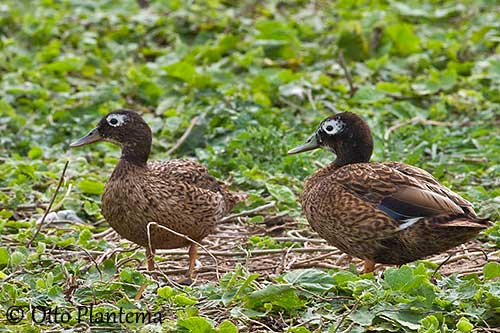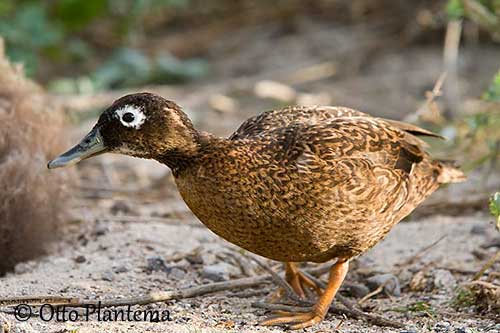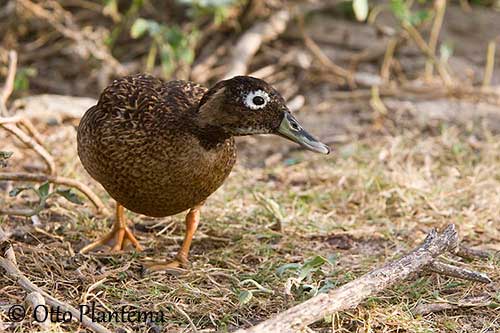
Fr: Canard de Laysan
All: Laysanente
Esp: Ánade de Laysan
Ita: Germano di Laysan
Nd: Laysaneend
Sd: Laysanand
Photographer:
Otto Plantema
Trips around the world
Text by Nicole Bouglouan
Sources:
GUIDE DES CANARDS, DES OIES ET DES CYGNES – de Steve Madge - Delachaux et Niestlé - ISBN: 2603013769
BirdLife International (BirdLife International)
Animal Diversity Web (University of Michigan Museum of Zoology)
What Bird-The ultimate Bird Guide (Mitchell Waite)
Laysan Duck
Anas laysanensis
Anseriformes Order – Anatidae Family
INTRODUCTION:
This small duck is endemic to Laysan Island, in NW Hawaiian Islands. The Laysan Duck is sometimes considered a Mallard’s subspecies, but its roots are much debated, and other suggestions mention the Hawaiian Duck as its true origin.
This Critically Endangered species is still threatened, due to small populations (500/680 mature birds) and restricted range. It is vulnerable to bad weather, disease, introduced species, both animal and vegetal ones, and degradation of the habitat.
DESCRIPTION OF THE BIRD:
Biometrics:
Length: 35-41 cm
Weight: M: 447 g – F: 451 g
The adult male has dull, dark chestnut to reddish-brown plumage overall, with darker brown subterminal spots to feathers. On the wing, there is a glossy green or blue speculum, bordered with white above and below. The tail shows slightly up curved central rectrices.
The underparts are similar, but the underwing is pale greyish with brown coverts.
Head and neck show variable amount of white feathers, and we can see a conspicuous white eyering.
The male has dull green bill with dark culmen and nail. The eyes are dark brown. Legs and feet are orange all year round.
The female is almost similar, but she has slightly browner upperparts. The wing speculum is dull brown. Her bill is brownish-yellow with dark nail and culmen.
The juvenile resembles adults.
RANGE:
The Laysan Duck is found on the small Laysan Island (about 370 hectares). This island is a protected reserve. About 100 ducks have been translocated to two other islands of the Midway Atoll, a wildlife refuge too.
HABITAT:
The Laysan Duck is usually found on the shores of the brackish lagoon in the centre of the island. This species is also visible along the sea coasts.
CALLS AND SONGS: SOUNDS BY XENO-CANTO
The Laysan Duck male utters low, soft, hoarse “quek-quek-quek” whereas the female gives some “quack”. These sounds are mainly heard during the courtship displays.

BEHAVIOUR IN THE WILD:
The Laysan Duck feeds mainly in the evening, at night and during the early morning. Its main food is the brine fly (Ephydridae), but it also takes shrimps, insect larvae, snails and moths, and plant matter such as grass and sedge seeds and some algae.
It has a peculiar feeding behaviour when hunting for flies: it runs through the swarms with neck outstretched forwards and wide open bill, in order to receive directly the flies in the bill.
When feeding on aquatic plant seeds, it dips its head into the water. This species does not dive or swim very often, but it dabbles and performs upending. It moves by walking or running on the ground. It rests during midday.
During the breeding season, the males fight to attract females, and they sometimes pull at each other’s breast feathers. Pairs are semi-permanent, and both mates can remain together for several following years. The copulation takes place on land.
The Laysan Duck is sedentary on Laysan Island. The food resources stay constant year round, and the ducks do not need to move for feeding.
This species has strong wings but it rarely flies, although it is able to take-off quickly. However, it cannot perform prolonged and sustained flights.

REPRODUCTION OF THIS SPECIES:
The breeding season takes place between late autumn and April-June.
After the copulation, the female builds a nest in a concealed location, in tussock grass or under bushes, and usually around the edges of the lagoon. The nest is made with dry grasses and placed on the ground.
She lays 3-4 whitish to greenish eggs, and incubates alone during 28 days. The male does not take part in nesting duties.
Breeding success depend largely on brine fly populations.
PROTECTION / THREATS / STATUS:
The Laysan Duck is affected by winter storms, and recently by tsunami, involving a 25% decline on Laysan. The population established on Midway Atoll in 2004/2005 suffered a setback with about 160 birds killed by avian botulism in 2008 and the following years. However, the numbers have slightly increased over the last 10 years.
This species is threatened by harsh weather, disease, introduced species, invasive plants threatening nesting and wetland habitats, and changes in this habitat.
The small populations in very restricted range, added to the previous main threats, make this species listed as Critically Endangered.
The Laysan Duck inhabits protected areas, and conservation measures to maintain the habitat are active. Other translocation of a captive population could be made for Kure or Lisianski Islands, in NW Hawaiian Islands.
Currently, the future of this species in not completely secure…
